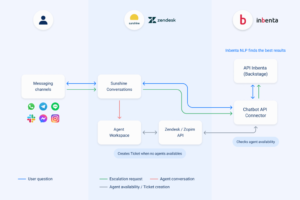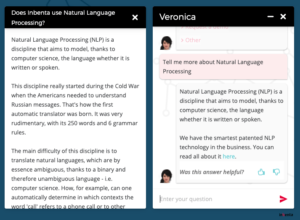Knowledge is power… but you need a solid system in place to extract that power successfully. In a customer-centric era focused on providing services with intelligence, availability, and excellence, implementing a knowledge management system (KMS) has become increasingly important. Knowledge Management (KM) is a cornerstone to the success of any Artificial Intelligence (AI) initiative. Chatbot / Voicebot / FAQ / Search Engine projects rely on a knowledge base from which they provide answers to customers. Naturally, the utility of the answers these projects provide depends upon the richness of the knowledge base behind those answers.
Now that you have this idea in hand, what are you to do with it? How, then, to implement a knowledge management system? Do not worry, you are in the right place – we at Inbenta are here to give you insights on the processes and best practices and provide a knowledge management framework to follow.
Framework of a knowledge management system that brings power
There are many ways to approach KM and the one you will select for your company will depend on its culture, structure, and its existing processes. Whatever the approach you decide to go for, implementing KM will impact People, Technology, and Processes.
When you start thinking about implementing a knowledge management system, brainstorm with yourself and your team along the following lines:
- PEOPLE: Who is the KM created for? Who is going to be involved in the KMS project? What are their roles and responsibilities?
- TECHNOLOGY: Which tools and technology are going to be used to support this KMS project? Technology enables people to communicate, but also helps to search for and find knowledge, and to access it inside the KMS.
- PROCESS: A strong system should be defined for each phase of knowledge management, while also maintaining flexibility.

Knowledge management best practices
Step 1 – Identify sources of knowledge
Companies have multiple sources of knowledge and the first step should be identifying these. For this step you need to have a deep sense of the flow of knowledge in your organization. Start from what exists first and design your KM process based on that. Who or what brings knowledge to your company? Where is that information stored? What does it say? How is it shared today?
Step 2 – Collect and capture Information
Once you know how the information flows through your organization and thus where to find it, you must categorize, map, organize and store it. The goal of this step is to make it more accessible, and faster to use, by giving some structure to the flow of information.
Step 3 – Process information
Next, you must analyze the information you have collected through the 2 first steps. The idea here is to consolidate, organize and review the information to see how it can best be used for your organization, combining information, and understanding to build knowledge. Implementing a knowledge management system is a big project, one that gets at the core of a company and can represent a real cultural shift. In this phase involving your employees as instigators of change, nurturing, and developing their innovative spirit, is a key success factor.
Step 4 – Organize, store, and share knowledge
Last but not least, make all of this knowledge accessible. Building an efficient knowledge management system is key but what makes the difference in use is human, the people who will utilize, nurture, and maintain your knowledge base. Therefore, they need to understand how to use the system and you may want to train them to the tool.

Symbolic AI and NLP at the core of the knowledge management framework
Just as the chatbot itself, a knowledge management system can be powered by different technologies and impact your performance differently whether you are using a regular type of AI or Symbolic AI.
AI in KMS takes the place of human consultants who analyze data and monitor KM processes. A knowledge management system based on Symbolic AI and NLP (Natural Language Processing) can understand human language easily and immediately retrieve the right information.
Inbenta knowledge Management System understands your customers in more than 30 languages. Its patented and proprietary Natural Language Processing Technology understands nuance in all these languages and is coupled with a rich lexicon, making it possible for Inbenta’s Customer Interaction Platform to recognize user intent and present users with the best replies and conversations.
Inbenta offers many (GDPR compliant) possibilities to help build a relevant knowledge base to reach your goals and provide you with a specific knowledge management framework to ensure your chatbot is working as efficiently as possible.

Source: https://www.inbenta.com/en/blog/knowledge-management-framework/
- "
- access
- AI
- All
- artificial intelligence
- Artificial intelligence (AI)
- availability
- BEST
- best practices
- build
- Building
- business
- change
- chatbot
- company
- conversations
- Culture
- Customers
- data
- Design
- employees
- FAQ
- First
- Flexibility
- flow
- follow
- Framework
- Free
- GDPR
- Giving
- here
- How
- How To
- HTTPS
- idea
- identify
- Impact
- information
- Initiative
- insights
- Intelligence
- intent
- interaction
- involved
- IT
- Key
- knowledge
- Knowledge Management
- language
- Languages
- Making
- management
- map
- Natural Language
- Natural Language Processing
- nlp
- Offers
- People
- performance
- platform
- power
- present
- project
- projects
- review
- Search
- search engine
- sense
- Services
- Share
- shared
- shift
- start
- store
- success
- support
- system
- Systems
- Technologies
- Technology
- Thinking
- tips
- top
- trial
- users
- utility
- WHO










